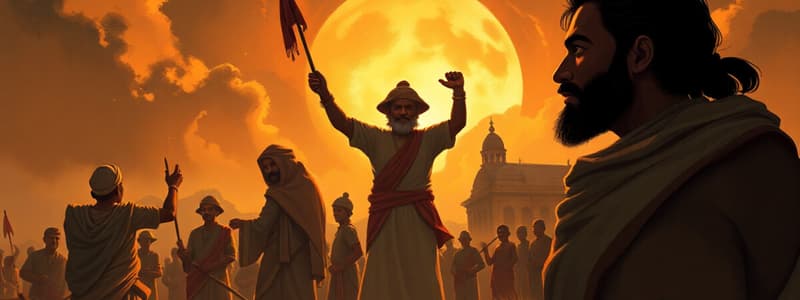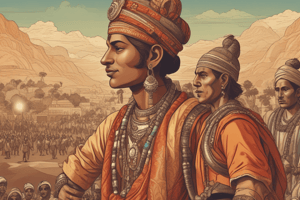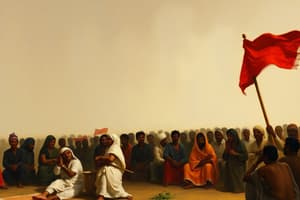Podcast
Questions and Answers
What was a primary demand of the peasant movement in Awadh?
What was a primary demand of the peasant movement in Awadh?
- Reduction of agricultural subsidies
- Abolition of begar (correct)
- Stricter regulations on tenant evictions
- Increased rent payment to landlords
Who led the peasant movement known as the Bardoli Satyagraha?
Who led the peasant movement known as the Bardoli Satyagraha?
- Vallabhbhai Patel (correct)
- Baba Ramchandra
- Mohandas Gandhi
- Jawaharlal Nehru
What strategy was used to pressure landlords in the villages?
What strategy was used to pressure landlords in the villages?
- Organizing nai-dhobi bandhs (correct)
- Public demonstrations with armed protests
- Reduction of land lease rates
- Collaborating with foreign investors
Which event marked the beginning of the Oudh Kisan Sabha?
Which event marked the beginning of the Oudh Kisan Sabha?
What misconception did local leaders promote regarding Gandhiji's declarations?
What misconception did local leaders promote regarding Gandhiji's declarations?
What major social issue did the peasant movement target against landlords and talukdars?
What major social issue did the peasant movement target against landlords and talukdars?
What resulted from the actions of the peasant movement in the early 1920s?
What resulted from the actions of the peasant movement in the early 1920s?
Which of the following contributed to the peasants' lack of security of tenure?
Which of the following contributed to the peasants' lack of security of tenure?
What was the main purpose of Mahatma Gandhi's letter to Viceroy Irwin on 31 January 1930?
What was the main purpose of Mahatma Gandhi's letter to Viceroy Irwin on 31 January 1930?
What was considered the most oppressive aspect of British rule, according to Gandhi?
What was considered the most oppressive aspect of British rule, according to Gandhi?
How long did Mahatma Gandhi's Salt March last?
How long did Mahatma Gandhi's Salt March last?
What was Gandhi's ultimate goal in launching the Civil Disobedience Movement?
What was Gandhi's ultimate goal in launching the Civil Disobedience Movement?
Which class of people did the Salt March primarily aim to unite?
Which class of people did the Salt March primarily aim to unite?
What significant action did Gandhi take upon reaching Dandi on 6 April?
What significant action did Gandhi take upon reaching Dandi on 6 April?
What method did Gandhi advocate for during the Civil Disobedience Movement?
What method did Gandhi advocate for during the Civil Disobedience Movement?
Why did Gandhi choose salt as a symbol for the movement?
Why did Gandhi choose salt as a symbol for the movement?
What special powers did Alluri Sitaram Raju claim to possess?
What special powers did Alluri Sitaram Raju claim to possess?
How did Raju demonstrate his influence on the rebels?
How did Raju demonstrate his influence on the rebels?
Which movement inspired Raju in his actions?
Which movement inspired Raju in his actions?
What approach did Raju advocate for India's liberation?
What approach did Raju advocate for India's liberation?
What was a key consequence of the Inland Emigration Act of 1859 for plantation workers?
What was a key consequence of the Inland Emigration Act of 1859 for plantation workers?
How did the plantation workers respond to the Non-Cooperation Movement?
How did the plantation workers respond to the Non-Cooperation Movement?
What ultimately happened to Alluri Sitaram Raju in 1924?
What ultimately happened to Alluri Sitaram Raju in 1924?
What did the notion of swaraj mean for plantation workers in Assam?
What did the notion of swaraj mean for plantation workers in Assam?
What was one of Dr. B.R. Ambedkar's significant demands at the second Round Table Conference?
What was one of Dr. B.R. Ambedkar's significant demands at the second Round Table Conference?
What was Gandhiji's concern regarding separate electorates for dalits?
What was Gandhiji's concern regarding separate electorates for dalits?
What was the result of the Poona Pact of September 1932?
What was the result of the Poona Pact of September 1932?
What was the reaction of many Muslim political organizations towards the Civil Disobedience Movement?
What was the reaction of many Muslim political organizations towards the Civil Disobedience Movement?
What contributed to the worsening relations between the Hindu and Muslim communities in the mid-1920s?
What contributed to the worsening relations between the Hindu and Muslim communities in the mid-1920s?
Which event exemplified the deepening divide between Hindus and Muslims during the period discussed?
Which event exemplified the deepening divide between Hindus and Muslims during the period discussed?
What was the initial sentiment of the dalit movement towards the Congress-led national movement?
What was the initial sentiment of the dalit movement towards the Congress-led national movement?
What was the outcome of the Congress's association with the Hindu Mahasabha?
What was the outcome of the Congress's association with the Hindu Mahasabha?
What was a significant reason for Congress's reluctance to include workers' demands in its struggle program?
What was a significant reason for Congress's reluctance to include workers' demands in its struggle program?
How did women participate in the Civil Disobedience Movement?
How did women participate in the Civil Disobedience Movement?
What demographic primarily made up the women participating in urban protests?
What demographic primarily made up the women participating in urban protests?
What was one of the motivations for women to participate in the Civil Disobedience Movement?
What was one of the motivations for women to participate in the Civil Disobedience Movement?
What was unique about women's participation in the nationalist processions?
What was unique about women's participation in the nationalist processions?
What impact did the participation of women have on their societal role during the Civil Disobedience Movement?
What impact did the participation of women have on their societal role during the Civil Disobedience Movement?
What actions did women take against foreign goods during the Civil Disobedience Movement?
What actions did women take against foreign goods during the Civil Disobedience Movement?
Which statement best describes the overall involvement of women in the Civil Disobedience Movement?
Which statement best describes the overall involvement of women in the Civil Disobedience Movement?
Study Notes
Peasant Movements
- Peasants in India were burdened by high rents, forced labour (begar) and insecure tenures.
- Jawaharlal Nehru, Baba Ramchandra and others setup the Oudh Kisan Sabha in October 1920.
- The Oudh Kisan Sabha had over 300 branches within a month.
- The Bardoli Satyagraha in Gujrat, led by Vallabhbhai Patel in 1928, protested against increased land revenue.
- The movement was widely publicized and garnered support across India.
Alluri Sitaram Raju
- Alluri Sitaram Raju, revered by the Gudem rebels as an incarnation of God, believed in armed resistance.
- He encouraged wearing khadi and stopping alcohol consumption.
- He orchestrated attacks on police stations, attempted to kill British officials and engaged in guerrilla warfare aiming for Swaraj.
- Raju was captured and executed in 1924, becoming a folk hero.
Plantation Workers
- Plantation workers in Assam sought freedom to move freely in and out of the confined plantation spaces.
- The Inland Emigration Act of 1859 restricted worker movement without permission.
- Thousands of workers, inspired by the Non-Cooperation Movement, defied the government and left the plantations.
The Salt March
- Mahatma Gandhi launched the Salt March on March 12, 1930, to protest the salt tax and government monopoly.
- He issued an ultimatum to the Viceroy Lord Irwin with 11 demands, focusing on unifying all social classes against British subjugation.
- Gandhi led 78 volunteers on a 240-mile march from Sabarmati Ashram to Dandi, lasting 24 days.
- The march aimed to educate Indians on the meaning of Swaraj and encourage peaceful resistance.
- Gandhi’s act of breaking salt laws in Dandi on April 6th marked the beginning of the Civil Disobedience Movement.
Participation in the Civil Disobedience Movement
- Women actively participated in the movement, venturing out of their homes to listen to Gandhi, join marches, manufacture salt and boycott foreign goods.
- Dalit participation was limited, particularly in regions with strong Dalit organizations.
- Dr. B.R. Ambedkar, advocating for separate electorates for Dalits, clashed with Gandhi, who feared it would slow integration.
- The Poona Pact (1932) granted reserved seats for Dalits in legislative councils but without separate electorates.
- Muslim political groups were lukewarm in their response due to their alienation from the Congress and the rising Hindu-Muslim tensions.
- Communal riots deepened the divide between Hindu and Muslim communities.
Congress and Swaraj
- The Congress aimed to unify all anti-imperial forces and prioritize broad-based demands to avoid alienating industrialists.
- The Congress struggled to engage with worker demands, fearing alienation of industrialists.
- The Congress felt the British government in India perpetuated exploitation and economic ruin, demanding complete independence or ‘Purna Swaraj’.
Studying That Suits You
Use AI to generate personalized quizzes and flashcards to suit your learning preferences.
Related Documents
Description
Explore the significant peasant movements in India, including the establishment of the Oudh Kisan Sabha and the Bardoli Satyagraha led by Vallabhbhai Patel. Learn about the impact of Alluri Sitaram Raju, his philosophy, and actions against British rule. This quiz highlights important social and political transformations in colonial India.




